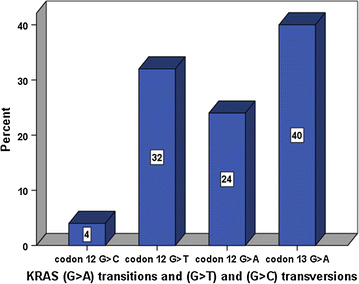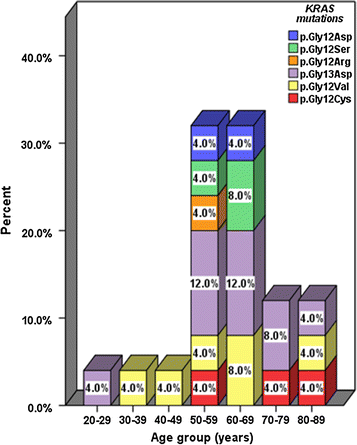The pattern of KRAS mutations in metastatic colorectal cancer: a retrospective audit from Sri Lanka
- PMID: 28797274
- PMCID: PMC5553606
- DOI: 10.1186/s13104-017-2731-5
The pattern of KRAS mutations in metastatic colorectal cancer: a retrospective audit from Sri Lanka
Abstract
Objective: Activating mutations in the KRAS gene, found in approximately 53% of metastatic colorectal cancer (mCRC) cases, can render epidermal growth factor receptor (EGFR) inhibitors ineffective. Regional differences in these mutations have been reported. This is the first study which aims to describe the pattern of KRAS mutations in a Sri Lankan cohort of mCRC patients.
Results: The KRAS genotypes detected in mCRC patients which have been maintained in an anonymized database were retrospectively analyzed. Of the 108 colorectal tissue samples tested, 25 (23.0%) had KRAS mutations. Overall, there were 68 (63.0%) males and 40 (37.0%) females. Among the KRAS positive cases, there were 14 (56.0%) males and 11 (44.0%) females. Their age distribution ranged from 29 to 85 years with a median age of 61 years. There were 15 patients (60.0%) with point mutations in codon 12 while 10 (40.0%) had a single mutation in codon 13. The most common KRAS mutation identified was p.Gly13Asp (40.0%), followed by p.Gly12Val (24.0%). Other mutations included p.Gly12Cys (12.0%), p.Gly12Ser (12.0%), p.Gly12Asp (8.0%), and p.Gly12Arg (4.0%). The codon 13 mutation was a G>A transition (40.0%), while G>T transversions (32.0%), G>A transitions (24.0%), and G>C transversions (4.0%) were found in the codon 12 mutations. The frequency of KRAS mutations was similar to that reported for Asian patients. However, in contrast to several published studies, the G>A transition in codon 12 (c.35G>A; p.Gly12Asp), was not the most common mutation within codon 12 in our cohort. This may be a reflection of the genetic heterogeneity in the pattern of KRAS mutations in mCRC patients but valid conclusions cannot be drawn from these preliminary findings due to the small size of the study sample.
Keywords: Colorectal carcinoma; Epidermal growth factor receptor; Genotype; KRAS gene; Mutation.
Figures
Similar articles
-
[Detection of KRAS gene mutation and its clinical significance in colorectal adenocarcinoma].Zhonghua Bing Li Xue Za Zhi. 2012 Oct;41(10):667-70. doi: 10.3760/cma.j.issn.0529-5807.2012.10.005. Zhonghua Bing Li Xue Za Zhi. 2012. PMID: 23302307 Chinese.
-
[The role of KRAS gene mutation testing in colorectal cancer--a predictive biomarker of response to EGFR inhibitors therapy].Lijec Vjesn. 2011 Nov-Dec;133(11-12):403-7. Lijec Vjesn. 2011. PMID: 22329297 Croatian.
-
Analysis of KRAS mutations in cases of metastatic colorectal cancer at a single institution in Tochigi, Japan.Pathobiology. 2014;81(3):133-7. doi: 10.1159/000357812. Epub 2014 Mar 8. Pathobiology. 2014. PMID: 24642668
-
Association between KRAS codon 13 mutations and clinical response to anti-EGFR treatment in patients with metastatic colorectal cancer: results from a meta-analysis.Cancer Chemother Pharmacol. 2013 Jan;71(1):265-72. doi: 10.1007/s00280-012-2005-9. Epub 2012 Oct 23. Cancer Chemother Pharmacol. 2013. PMID: 23090619 Review.
-
KRAS status and resistance to epidermal growth factor receptor tyrosine-kinase inhibitor treatment in patients with metastatic colorectal cancer: a meta-analysis.Colorectal Dis. 2014 Nov;16(11):O370-8. doi: 10.1111/codi.12749. Colorectal Dis. 2014. PMID: 25155261 Review.
Cited by
-
A Systematic Review and Meta-analysis on the Occurrence of Biomarker Mutation in Colorectal Cancer among the Asian Population.Biomed Res Int. 2022 Jun 23;2022:5824183. doi: 10.1155/2022/5824183. eCollection 2022. Biomed Res Int. 2022. PMID: 35782059 Free PMC article.
-
Genomic Characterization of High-Grade Serous Ovarian Carcinoma Reveals Distinct Somatic Features in Black Individuals.Cancer Res. 2025 May 2;85(9):1725-1737. doi: 10.1158/0008-5472.CAN-24-1879. Cancer Res. 2025. PMID: 40063699
-
KRAS, NRAS and BRAF Mutational Profile of Colorectal Cancer in a Series of Moroccan Patients.Cancer Control. 2024 Jan-Dec;31:10732748241262179. doi: 10.1177/10732748241262179. Cancer Control. 2024. PMID: 38875469 Free PMC article.
-
AsiDNA Treatment Induces Cumulative Antitumor Efficacy with a Low Probability of Acquired Resistance.Neoplasia. 2019 Sep;21(9):863-871. doi: 10.1016/j.neo.2019.06.006. Epub 2019 Jul 27. Neoplasia. 2019. PMID: 31362243 Free PMC article.
-
COL1A1: A potential therapeutic target for colorectal cancer expressing wild-type or mutant KRAS.Int J Oncol. 2018 Nov;53(5):1869-1880. doi: 10.3892/ijo.2018.4536. Epub 2018 Aug 22. Int J Oncol. 2018. PMID: 30132520 Free PMC article.
References
-
- Cancer Registry, National Cancer Control Programme. Sri Lanka cancer incidence data 2007; 2013.
-
- Inoue Y, Saigusa S, Iwata T, Okugawa Y, Toiyama Y, Tanaka K, et al. The prognostic value of KRAS mutations in patients with colorectal cancer. Oncol Rep. 2012;28:1579–1584. - PubMed
MeSH terms
Substances
LinkOut - more resources
Full Text Sources
Other Literature Sources
Medical
Research Materials
Miscellaneous




